As EmBe celebrates its 100th anniversary, we are digging through our history to discover some of the trail-blazing women who defined our values and shaped our history. While looking through the archives, one name popped up repeatedly, continuously doing good for the community and shaping the YWCA into what it is today. This woman was one of the organization’s first members, one of the most influential figures in the Sioux Falls civil rights movement, and one of the most prominent beauty figures in South Dakota history. For our Sunday Story this week, we’re highlighting the life of Louisa Mitchell!
Beauty
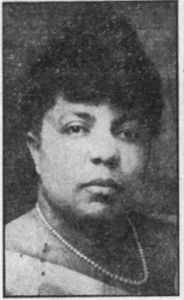 Louisa Mitchell came to Sioux Falls with her husband Harvey in 1906 – 15 years before the YWCA would be founded. When they arrived, Harvey took a job at a barber shop, and Louisa set up a beauty store right out of their living room. She was immediately recognized for her talent and overwhelmed with people ready to get their hair done. She didn’t have all the proper equipment in her home, so she substituted a kitchen bowl for washing hair, a kerosene lamp and electric fan for drying hair, and an actual iron for straightening hair. After just a couple of days, a woman came to get her hair done; she loved it so much that she went to the Shriver-Jonhson company and recommended that they hire Louisa. Weeks later, Louisa opened the Mezzanine Beauty Parlor in the Shriver-Johnson department store – the largest store in South Dakota at the time.
Louisa Mitchell came to Sioux Falls with her husband Harvey in 1906 – 15 years before the YWCA would be founded. When they arrived, Harvey took a job at a barber shop, and Louisa set up a beauty store right out of their living room. She was immediately recognized for her talent and overwhelmed with people ready to get their hair done. She didn’t have all the proper equipment in her home, so she substituted a kitchen bowl for washing hair, a kerosene lamp and electric fan for drying hair, and an actual iron for straightening hair. After just a couple of days, a woman came to get her hair done; she loved it so much that she went to the Shriver-Jonhson company and recommended that they hire Louisa. Weeks later, Louisa opened the Mezzanine Beauty Parlor in the Shriver-Johnson department store – the largest store in South Dakota at the time.
Just a short while after opening the salon, Louisa opened the California School of Beauty Culture. In this place, women could come to take classes in beauty and graduate with the knowledge needed to take the beauty examination for the state. When the school opened, Harvey quit his job and came to work with Louisa in the store.
Louisa was undoubtedly a pioneer of the beauty industry in South Dakota. She was the first in the state to own a permanent waving machine and the first in the state to open a beauty school.
After two years of running the beauty salon and the beauty school, Louisa also decided to open a doll hospital. The hospital was opened in the Shriver-Johnson department store next to her beauty salon. The services available were doll repair, custom clothes, and human-hair wig creation. Mothers could bring in locks of their hair and have them made into a wig for a doll given to their daughters. If the mothers didn’t have any hair, there were pre-made wigs ready to buy made from the hair cut-off in the beauty salon. (This sounds gross, but it was a popular thing in the 20s and 30s).
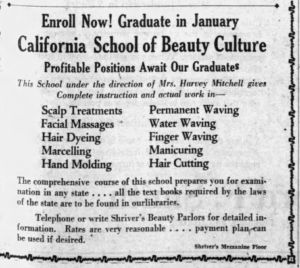 .
. 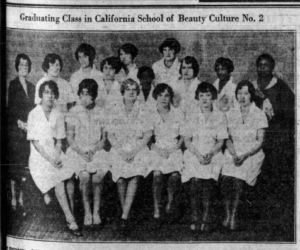
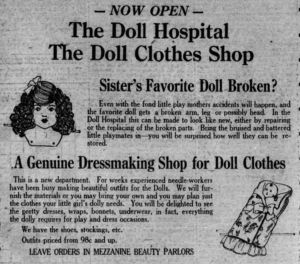
Activism
When Louisa and Harvey first moved to Sioux Falls, they began to take in guests who had nowhere else to stay. They regularly housed store workers, travelers, and even a group of French Painters. Her brother, the first black man admitted to the bar exam in Sioux Falls, also stayed with them frequently.
In 1930 – after 24 years of housing guests – Louisa and Harvey decided to open the Booker T. Washington Service Center. This community center was designed to help black travelers and new residents find a welcoming and affordable place to stay in Sioux Falls when other sites refused them. It was also a recreation center and regularly held events such as quilt making, church events, concerts (including “The World Famous Williams Colored Singers”), singing and dancing, parties, discussion circles, committee meetings, and club meetings.
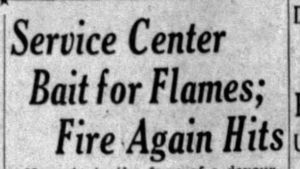 After two years of fantastic success with the center, the building started on fire in January 1932. What began as a small, manageable fire turned to chaos when the firefighters were given the wrong address. By the time they arrived, the building had been gutted completely and was unsavable. Louisa and Harvey temporarily moved the center’s operations to their home – taking the responsibility of housing guests, holding meetings, and hosting events. However, bad luck seemed to follow them, and after just a week, a small fire started in their home and burned down a wall. A couple of months later, in August of 1932, Mitchell’s luck turned around, and they were able to relocate to a larger building that could house double the number of people as the original building.
After two years of fantastic success with the center, the building started on fire in January 1932. What began as a small, manageable fire turned to chaos when the firefighters were given the wrong address. By the time they arrived, the building had been gutted completely and was unsavable. Louisa and Harvey temporarily moved the center’s operations to their home – taking the responsibility of housing guests, holding meetings, and hosting events. However, bad luck seemed to follow them, and after just a week, a small fire started in their home and burned down a wall. A couple of months later, in August of 1932, Mitchell’s luck turned around, and they were able to relocate to a larger building that could house double the number of people as the original building.
Along with the Booker T. Washington Center, Louisa and Harvey were active in the Sioux Falls civil rights movement. They regularly protested racist statues and paintings and frequently talked at city board meetings. They even complied the signatures from important figures on a letter sent to congress asking them to vote for the law against lynching.
Louisa was one of the first presidents of the NAACP (National Association for the Advancement of Colored People) of South Dakota. She organized countless events with famous black singers, speakers, and influential figures in this role. This organization was crucial in the fight for civil rights; with Louisa as the president, extensive progress was made.
YWCA
Louisa was one of the first members of the YWCA in Sioux Falls. She participated in many of the events and volunteered whenever there was an opportunity to do so. In 1925, after being an active member for four years, Louisa was elected as the first black president of the IIC (Intellectual Improvement Club). This club focused on the improvement of different crafts and the learning of new skills.
Also, in 1925, Louisa founded the Colored Girls’ Club, a club specifically for the black members of the YWCA. This club discussed black history, planned civil rights events, and created a community for the black women of the organization.
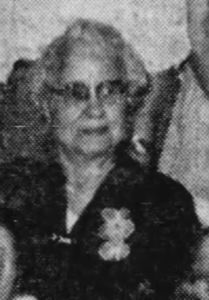 In 1928, Louisa became the first black woman on the YWCA board of directors. Many people were skeptical about her placement, but Louisa blew them away with her unique ideas and steadfast capability. No matter the challenge, Louisa tackled it with creativity and intelligence.
In 1928, Louisa became the first black woman on the YWCA board of directors. Many people were skeptical about her placement, but Louisa blew them away with her unique ideas and steadfast capability. No matter the challenge, Louisa tackled it with creativity and intelligence.
Sometime in the 1930s, Louisa helped to organize the YWCA Get-Together Picnics. These picnics were an annual event held in July in either Sioux Falls, Yankton, Huron, or Mitchell. Southern soul food was served at this picnic, and many activities were hosted, including singing, games, and speakers from across the country. These picnics lasted until 1965, when they were discontinued.
Louisa died in 1942, 3 months after her husband. While she is gone, her legacy will live on forever in the history of South Dakota and EmBe. Louisa was a trailblazer in civil rights, beauty, and the YWCA. With her spirit in mind, EmBe hopes to spend the next 100 years continuing to break down barriers and lead the way for the Sioux Falls community.
Read EmBe’s latest news
Read EmBe’s latest news
Welcome EmBe’s 2025 Summer Interns
Welcome EmBe's 2025 Summer Interns Every year, EmBe welcomes [...]
Transformation through EmBe’s Women’s Leadership Program
Transformation through EmBe’s Women’s Leadership Program Before her journey [...]
Get Ready for an Unforgettable Summer with EmBe’s School Age Summer Care!
Our team is excited to make 2025 a year [...]
Donor Highlight: John and Paige Pearson-Meyer
Donor Spotlight: John and Paige Pearson Meyer We are [...]




